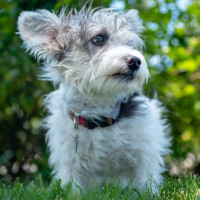Appearance of the Mauzer
|
| Each Mauzer can have its own unique look, depending on the dominant parental breed. First of all, expect him to be rather small. At a minimum, he'll weigh 3 kilos at maturity, but usually the Mauzer is closer to 7 kilos. The length and density of his coat also depend on the dominant parental breed. It can be rough and short, or long and silky. It can be black with gray highlights in the hair, or it can be dark gray all over. He may be a very light gray with just a little black around the ears. His nose will be black, and it is predominant on his face. His facial hair tends to be long, with some owners choosing to keep the hair trimmed there. His legs will be short and his small body is normally very slender. The tail may have long, feathery hairs. The tail may curl somewhat over its back. Expect bangs of hair on the legs. |
Temperament of the Mauzer
|
| The Mauzer is an excellent dog for singles, seniors and families with older children. Although the Mauzer is not aggressive towards young children, small children often haven't quite learned how to handle a small dog and may pull the dog's hair or otherwise injure it. Be aware that Mauzers tend to bond with only one person in the family. However, they are comfortable and affectionate with all family members. They have been known to follow their people around the house simply because they want to be with you. He's generally a happy dog, but he's also a good watchdog. He will bark if he sees anything abnormal around the house. He can be a bit stubborn at times, and you should be warned that he may chew from time to time. Otherwise, you can enjoy the Mauzer's energy and affection. |
Needs and activities of the Mauzer
|
| The Mauzer is an active dog that needs daily exercise. Don't forget that he's also highly intelligent and needs mental play as well as physical activity to keep him from getting bored. As with all dogs, if he gets bored, he can become destructive. You can choose to take a long walk with the Mauzer, or you can divide his activity time into short bursts throughout the day. He needs a variety of toys to keep him both physically and mentally occupied. He'll also enjoy a trip to the dog park, where he can walk and play with other dogs as well as you. If you have an enclosed backyard, the Mauzer will enjoy playing there while you work in the backyard. However, he should never be left unattended for long periods. Always provide access to water when the Mauzer is active outdoors. |
Maintenance of the Mauzer
|
| The Mauzer will require a moderate amount of grooming. Of course, some owners trim their Mauzer's fur for easier maintenance. The Mauzer is hypoallergenic, so you won't have to worry about a lot of shedding with him. It should be brushed at least twice a week, regardless of the length of the fur. You shouldn't bathe your Mauzer unless it's dirty, as its natural oils will keep its coat healthy and shiny. However, when you do need to wash him, choose a shampoo designed for sensitive dogs, remembering that the Mauzer tends to have dry skin. Some owners choose to trim not only the body hair, but also the hair on the Mauzer's feet. Brush his teeth at least three times a week to prevent tartar build-up and bad breath, and even better, brush daily to prevent tooth decay. Finally, keep his nails trimmed at least twice a month. |









 English (United Kingdom)
English (United Kingdom)